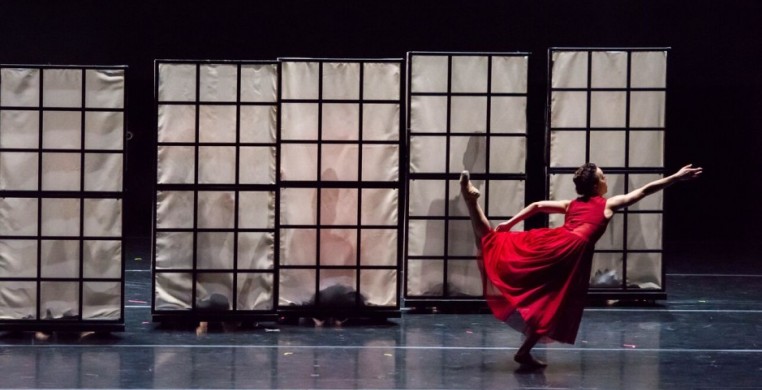At age 14, Sono Osato auditioned for the Ballet Russe de Monte Carlo onstage at the Auditorium Theatre in Chicago. She would become the youngest dancer to join the company, and the first of Japanese descent. Osato would go on to dance for American Ballet Theater and on Broadway, despite widespread anti-Japanese sentiment throughout the United States during World War II. On January 9, Osato, now age 96, will return to the place where her story began for “Sono’s Journey,” a world premiere by Thodos Dance Chicago.
“I really wanted this story to be told,” said Artistic Director Melissa Thodos in an interview with SeeChicagoDance. “[Osato] had her career at such an amazing time in history, and really encapsulates what was happening politically in our country.” The third of its kind (after The White City and A Light in the Dark, exploring the story of Helen Keller), Sono’s Journey is a long-form narrative dance that follows her story beginning with her audition onstage at the Auditorium Theater, the as part of the venue’s “Made in Chicago” series. In a series of happy accidents, Thodos’ work parallels Osato’s story, not only with Sono’s Journey, but with the 2011 acclaimed story ballet White City: Chicago’s Columbian Exposition of 1893, and a more recent legacy project restoring work by Agnes de Mille, whose work was performed by Osato and modern dance maverick Sybil Shearer (the subject of dance restoration projects at Thodos and the Chicago Dance History Project).
Furthermore, Osato and Thodos are linked to the history of the city surrounding the World’s Fair, and a recent surge to restore and revitalize park spaces that once hosted the Columbia Exposition. According to the Chicago Tribune, Landscape architect Frederick Law Olmsted once referred to the 540-acre green space south of the Museum of Science and Industry as a “poorly drained, swampy land along a shoreline vulnerable to erosion.” Olmsted was commissioned to design the space that would eventually become Jackson Park in 1869, but preferred to focus his attention on Washington Park, its neighbor to the west.
Olmsted must have changed his mind, since the once-swamp would eventually become the key fairgrounds for the 1893 World’s Columbian Exposition. Little remains of the once grand fairgrounds, after fire and neglect took most of the fair's architectural relics as victims, with the Museum of Science and Industry, the Field Museum (relocated to the south end of Grant Park), and the Japanese Garden as some of the only reminders of Jackson Park’s grandeur.
Jackson and Washington Park are recently back in competition, having received considerable attention over the past couple of years as the sites of major renovations and potential locations for the future Obama Presidential Library. Washington Park’s past and present revitalization projects have received some criticism, but Robert Karr and Project 120, the team spearheading renovations to Jackson Park, are committed to avoiding similar pitfalls.
The overhaul is being carefully planned to please park activists, community members, and others committed to preserving Olmsted’s vision. In addition to money, Karr has brought considerable foresight to the project by bringing on Olmsted experts Heritage Landscapes to plan the restoration in partnership with the Army Corps of Engineers, which includes $8.1M in ecological improvements, a $10M visitors’ center, and preservation of the Osaka Japanese Garden. The garden’s Phoenix Temple rose from the center of the Japanese Garden until it was burned out of spite in 1946, and Osato’s parents once managed the tea house until her Japanese-born father Shoji was held at an internment camp during World War II, about the same time Sono was starring on Broadway.
The link between Osato and the Jackson Park restoration led to a serendipitous conversation between Robert Karr and Thodos Dance Chicago’s Board President Sharon Lear. Thodos’ acclaimed White City was pitched to Karr as a point of conversation and potential collaboration, and the rest is pretty much history.
A first-generation Greek American, Thodos asked herself why Osato’s story spoke to her so deeply. Her parents grew up in Nazi-occupied Greece, and maintained a Greek household after moving to Chicago. Osato was born in Nebraska to a Japanese father and Canadian mother; while Thodos relates to her as a first-generation immigrant whose family was deeply affected by World War II, she also identifies with Osato’s journey as a dancer.
“Women in dance – It’s tough. It always has been and it will continue to be, which is why we need to keep doing what we’re doing,” she said. Thodos considers Osato a pioneer, and in some ways, their journeys have echoed one another’s. Thodos’ 16-year-old emerging choreographer series “New Dances” was one of the first in Chicago. She started her company when few women were doing it, maintaining a deep commitment to nurturing young artists for nearly 25 years.
February 20’s “Chicago Revealed” program at the North Shore Center for the Performing Arts will show the two women in tandem, with an encore of Sono’s Journey alongside the world premiere of Thio Kosmos. Greek for “two worlds,” Thio Kosmos further explores Thodos' roots and place within Chicago’s Greek community.
--
Sono’s Journey premieres January 9, 7:30 p.m. at the Auditorium Theatre at Roosevelt University, 50 E. Congress Pkwy. Tickets are $28-68, with a $10 discount code DANCE available from SeeChicagoDance.com

